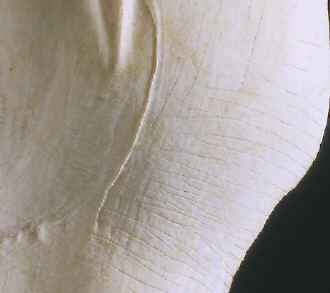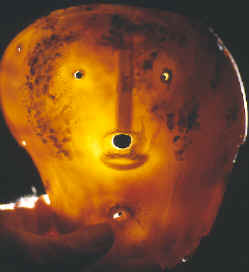|
ABSTRACT:

MARINE SHELL MASK GORGETS
MONTANA AND SOUTH DAKOTA
LATE PREHISTORIC 1450 TO 1675
This article illustrates and describes four shell masks. Two were surface
collected on different sites in South Dakota and two were found in
a cave in Montana. The specific information used to describe these
masks comes from two reports. One is from Michael Fosha, State
Archaeological Research Center, South Dakota and the other was
written by Stanley Jaynes, Bureau of Land Management, Lewistown
District, Montana. |
|
|
"According to local
Lakota beliefs these items may have been used in curing
ceremonies".---2001,
Michael Fosha, State Arch. Research Center, SD.
"It is suggested that
the Montana masks were a spirit offering, left by one of the Plains
tribes."---2001, Stanley Jaynes, BLM, lewistown District, Montana

THE TWO MASKS ON THE LEFT WERE
FOUND IN SOUTH DAKOTA
THE TWO MASKS ON THE RIGHT WERE FOUND IN MONTANA
MARINE
SHELL
MASK GORGETS
MONTANA AND SOUTH DAKOTA
LATE PREHISTORIC 1450 TO 1675
State
Archaeological Research Center, South Dakota and Bureau of Land
Management, Lewis District, Montana
The
above statements place these four artifacts into the more rare category of ceremonial
equipment. When the words
"offerings", "spirits", and "ceremonies"
are used to describe something the objects will probably never be completely
understood on the spiritual level. But recording the facts is the goal and
these shell masks are helping to increase the growing knowledge
of marine shell mask gorgets in the northwestern U.S.
|
|

CLICK ON
PICTURE FOR LARGE TRIPLE IMAGE
MARINE SHELL MASK GORGET
LATE PREHISTORIC
SOUTH DAKOTA
DONATED TO BEAR
BUTTE STATE PARK
This is the smaller of the two shell masks from South Dakota. It was
found sometime in the 1960's on a talus slope on an important
natural landmark located north of the Black Hills called Bear Butte.
This site has a strong connection to many Plains groups who consider
it to be a sacred location. Dr. Jim Fox of Invertebrate
Paleontology, SD School of Mines & Tec., Rapid City, SD believes
there is a chance that the shell this mask is made of could be a
fossil gastropod. Only chemical analysis could determine if it is a
fossil or a recent shell. This mask is in good condition but it has
lost its original shine or luster. It measures 5 3/16 inches ( 13.2
cm) long and 4 1/4 inches (10.8 cm) wide. |
|
|
Shell
is a raw material that has been used by humans all over the world all
the way back to the days of the Neanderthals. The tiniest of shells,
like marginella or olivella, were used for beads and the largest ones
like the large giant "man killer" clam shells of the South
Pacific were used to make such things as war club heads and wood working
tools like adzes. In North America, shells have been used to make cups,
spoons, fishhooks, knives, scrapers, clubs, picks, celts, adzes, gouges,
plummets, beads, pendants, earrings, pins, breastplates and gorgets.
|
|

CLOSE-UP OF
HORIZONTAL LINES ON THE SMALLER OF THE TWO SHELL MASKS FROM SOUTH
DAKOTA
LATE PREHISTORIC
DONATED TO BEAR
BUTTE STATE PARK
Invertebrate Paleontologist Dr. Jim Fox has studied this shell mask
and believes that the lines on the surface may be an indicator that
it's a fossil shell rather than a recent one. He says that lines
like the ones shown in this picture are common on some fossil
gastropods. |
|
|
This
article focuses on four carved marine shell mask gorgets, two from Montana and
two from South Dakota. The South Dakota masks were found on the surface
of the ground on widely separated sites. The smaller of the two
(pictured above) was found on a
talus slope sometime in the 1960's on Bear Butte, a site that is sacred
to many of the Plains Indians. In fact the Cheyenne believe it is their most
sacred location and is "the sacred mountain where people are
taught." Bear Butte is the name of the natural formation there. The
site is located just north of the Black Hills in western South Dakota.
|
|

CLOSE-UP OF THE
NOSE, EYES AND BROW RIDGE OF ONE OF THE EYES
LATE PREHISTORIC
SOUTH DAKOTA
DONATED TO BEAR
BUTTE STATE PARK
This close-up view shows some of the carved detail on the smaller
mask from South Dakota. Some of the surface of
the shell was carved down to form the brow ridges. The nose is
carved in relief and tapers
to a point that is slightly off center. This shell mask measures 2 3/8 inches
(6 cm) long. |
|
|
One interesting fact about the Bear Butte shell mask is that it may be made of fossil
shell rather than a recent one, according to Dr. Jim Fox, an Invertebrate
Paleontologist who studied it. He says that chemical analysis would be
needed in order to determine if it was a fossil.
|
|
CONTINUE ON TO PAGE
TWO
|
|
"REFERENCES"
1912,
Frederic Webb Hodge, "Handbook of American Indians North of
Mexico," pp.539-541.
2001, Michael Fosha, "Faces of Shell: Two Marine Shell Mask Gorgets
From South Dakota."
2002, Stanley Jaynes, "Marine Shell Mask Gorgets In Montana."
|
|
HOME
ORDERING |





